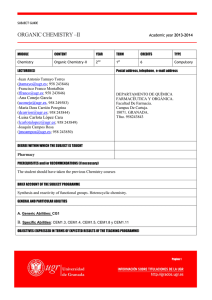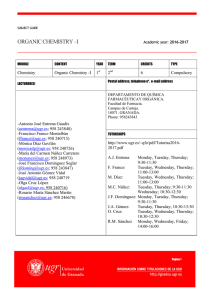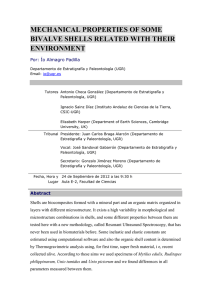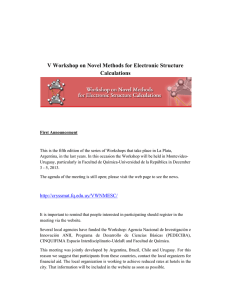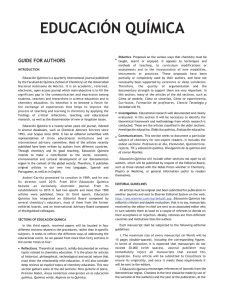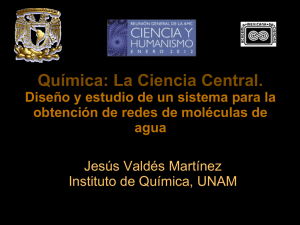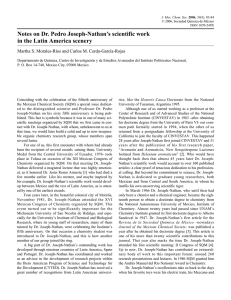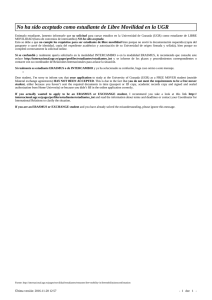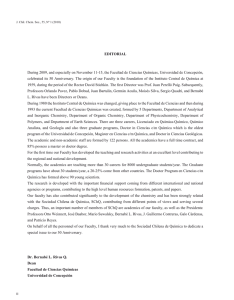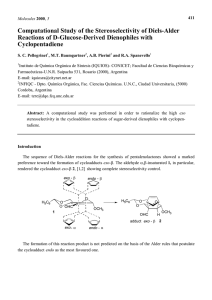Organic Chemistry-II
Anuncio
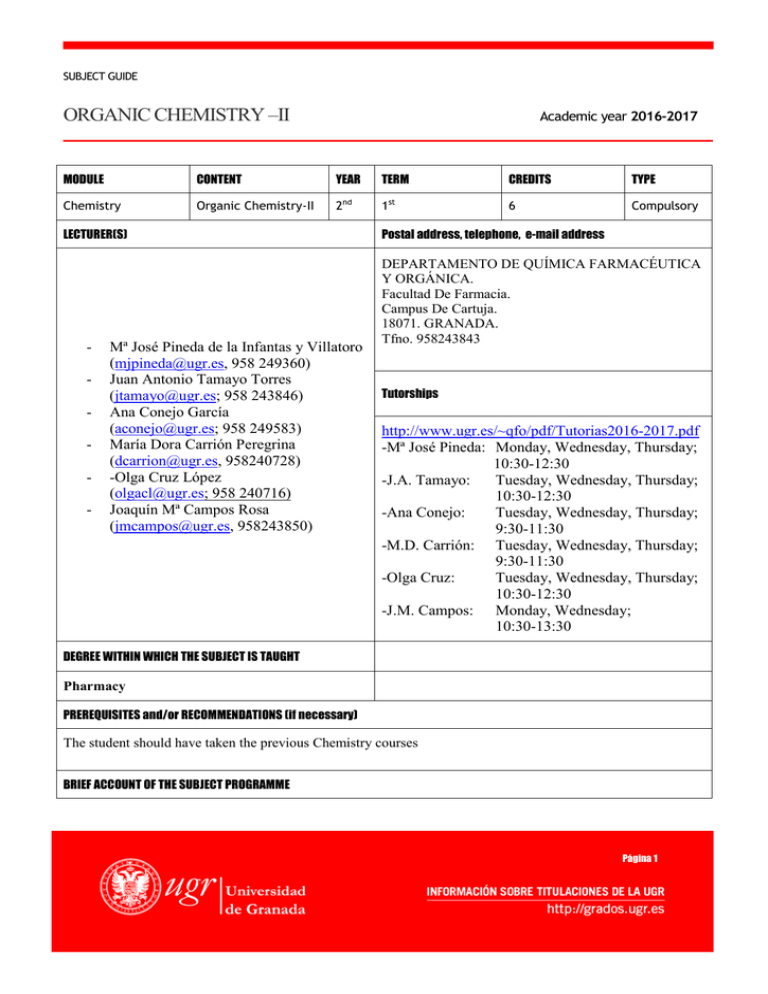
SUBJECT GUIDE ORGANIC CHEMISTRY –II Academic year 2016-2017 MODULE CONTENT YEAR TERM CREDITS TYPE Chemistry Organic Chemistry-II 2nd 1st 6 Compulsory LECTURER(S) - Mª José Pineda de la Infantas y Villatoro ([email protected], 958 249360) Juan Antonio Tamayo Torres ([email protected]; 958 243846) Ana Conejo García ([email protected]; 958 249583) María Dora Carrión Peregrina ([email protected], 958240728) -Olga Cruz López ([email protected]; 958 240716) Joaquín Mª Campos Rosa ([email protected], 958243850) Postal address, telephone, e-mail address DEPARTAMENTO DE QUÍMICA FARMACÉUTICA Y ORGÁNICA. Facultad De Farmacia. Campus De Cartuja. 18071. GRANADA. Tfno. 958243843 Tutorships http://www.ugr.es/~qfo/pdf/Tutorias2016-2017.pdf -Mª José Pineda: Monday, Wednesday, Thursday; 10:30-12:30 -J.A. Tamayo: Tuesday, Wednesday, Thursday; 10:30-12:30 -Ana Conejo: Tuesday, Wednesday, Thursday; 9:30-11:30 -M.D. Carrión: Tuesday, Wednesday, Thursday; 9:30-11:30 -Olga Cruz: Tuesday, Wednesday, Thursday; 10:30-12:30 -J.M. Campos: Monday, Wednesday; 10:30-13:30 DEGREE WITHIN WHICH THE SUBJECT IS TAUGHT Pharmacy PREREQUISITES and/or RECOMMENDATIONS (if necessary) The student should have taken the previous Chemistry courses BRIEF ACCOUNT OF THE SUBJECT PROGRAMME Página 1 Synthesis and reactivity of functional groups. Heterocyclic chemistry. GENERAL AND PARTICULAR ABILITIES A. Generic Abilities: CG1 B. Specific Abilities: CEM1.3, CEM1.4, CEM1.5, CEM1.8 y CEM1.11 OBJECTIVES (EXPRESSED IN TERMS OF EXPECTED RESULTS OF THE TEACHING PROGRAMME) The student should be able to: • • Understand and apply the knowledge comply in the subject. Use the basic organic chemistry laboratory operations in order to synthesize, purify and structurally characterize simple organic molecules. DETAILED SUBJECT SYLLABUS TEORIC CHAPTERS: • Chapter 1. AROMATIC HIDROCARBONS. Classification. Physical and spectroscopic properties. Natural source. Electrophilic aromatic substitution. Aryl halides. Nucleophilic aromatic substitution. • Chapter 2. HALOGENATED DERIVATIVES. Alkyl halides. Structure and physical properties. Synthesis. Unimolecular and bimolecular nucleophilic substitution. Allyl and vinyl halides. Organometallic compounds. • Chapter 3. ALCOHOLS, ETHERS AND PHENOLS. Alcohols: structure and classification. Physical and spectroscopic properties. Natural source and synthesis. Chemical reactivity. Transpositions. Acyclic and cyclic ethers. Phenols. Phenolic ethers. Sulfur analogs: Thiols and sulfides. • Chapter 4. AMINES. Structure. Physical properties. Synthesis. Chemical properties. Diazonium salts. Azocolorants. Quaternary ammonium salts decomposition: Hofmann elimination. • Chapter 5. ALDEHYDES AND KETONES. Structure. Physical and spectroscopic properties. Synthesis. Addition and addition-elimination reactions on carbonyl group. Wittig reaction. Reduction and oxidation reactions. Keto-enol tautomerism. Halogenation. Aldol condensation and related reactions. Unsaturated carbonyl compounds. Conjugate additions. • Chapter 6. CARBOXYLIC ACIDS. Structure. Physical and spectroscopic properties. Synthesis. Acid-base reactions. Transformations to acid derivatives. Reduction, halogenation and decarboxylation reactions. • Chapter 7. CARBOXYLIC ACID DERIVATIVES. Classification. Nomenclature. Physical properties. General reactivity of carboxylic acid derivatives. Claisen condensation and related reactions. Malonic ester synthesis. Acetoacetic ester synthesis. • Chapter 8. HETEROCYCLES. Nomenclature. π-Electron rich heterocycles. π-Electron deficient heterocycles. Reactivity of heterocycles. LABORATORY: • 1. Synthesis of aspirin. • 2. Synthesis of benzocaine. READING BASIC BIBLIOGRAPHY: - C. VOLLHARDT, N.E. SCHORE. Química Orgánica: Estructura y Función. Ed. Omega. 3ª Edición, 2008. Página 2 - DAVID KLEIN. Química Orgánica. Ed. Médica Panamericana, 1ª Ed. 2012. - F.A. CAREY. Química Orgánica. Ed. McGraw-Hill. 6ª Edición, 2006. - L.G. WADE, Jr. Química Orgánica. Ed. Pearson, 7ª Edición, 2012. - T. W. GRAHAM SOLOMONS. Organic Chemistry. Ed. Wiley. 10ª Edición, 2010. - G.M. LOUDON. Organic Chemistry. Oxford University Press, 2002. - J. CLAYDEN, N. GREEVES, S. WARREN, P. WOTHERS. Organic Chemistry. Oxford University Press, 2001. COMPLEMENTARY BIBLIOGRAPHY: - J. MARCH. Advanced Organic Chemistry: Reactions, Mechanisms, and Structure, 7ª edition Ed. Wiley, 2013. - F. A. Carey; R. J. Sundberg. Advanced Organic Chemistry, Part A: Structure and Mechanisms Advanced Organic Chemistry: Part B: Reaction and Synthesis 5 Edition, Ed Springer, 2007 PROBLEMS - F. GARCIA CALVO-FLORES, J. A. DOBADO, Problemas resueltos de Química Orgánica, Ed. Thomson, 1ªEd, 2007. - H. MEISLICH. Química Orgánica, (3ª Ed.). Ed. Mc Graw Hill-Interamericana, 2001. - E. QUIÑOÁ y R. RIGUERA. Cuestiones y ejercicios de Química Orgánica. Una guía de autoevaluación (2ª Ed.) Ed. Mc Graw Hill 2004. NOMENCLATURE - W.R. PETERSON. Formulación y Nomenclatura. Química Orgánica. EUNIBAR. - E. QUINOÁ, R. RIGUERA. Nomenclatura y representación de los compuestos orgánicos. Ed. Mc Graw-Hill, 2005. EVALUATION (EVALUATION CRITERIA) • • • • • • The evaluation will be based on exams and personal work made by the student along the semester. During the evaluation process the student must show a minimum and uniform knowledge of all the questions evaluated. Exceptionally, the teacher could ask for an additional and supplementary oral exam to justify the student knowledge. The practical lessons are mandatory to pass the subject. The student MUST ATTEND ALL the practical lessons and pass the corresponding exam. Calls to the practical lessons must be attended by all substitute students at the date and time specified in the call. Students with improperly justified absence during the call will not be call again. None of the passed exams will be saved for following academic years or for the September exams. Approved practices are not saved for the next academic year, neither for the special examination in September. Link to Criteria for Students Evaluation (UGR): http://farmacia.ugr.es/noticias/docu/NormEVALUACINYCALIFICACIN.pdf EVALUATION LEARNING OUTCOMES SE.1, SE.2, SE.3 and SE.4 Theory classes SE.7, SE.8, SE.9, SE.10, Laboratory classes, SE.5, SE.11, SE.12 and elaboration and exposition SE.15 of homework SE.15 Class attendance % MARKING 85-100 0-10 0-5 Página 3 The values in % of the markings will be set at the beginning of the course by the instructor/instructors of the subject. RECOMMENDED INTERNET LINKS • • • • • • Chemistry Dictionary ChemistryGuide IUPAC Nomenclature of Organic Chemisty Organic Syntheses Organic-Chemistry Departamento de Química Farmacéutica y Orgánica (UGR) Página 4
